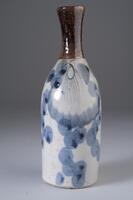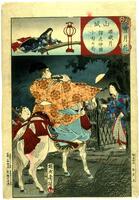45 UMMA Objects
45 UMMA Objects

Chinese (Chinese (culture or style))
Round Embroidery
1867 – 1932
Gift of Mr. and Mrs. Herbert W. Johe
1989/2.77

Zu Ze (Tsu-tse)
Both sides: Calligraphy
1867 – 1932
Museum Purchase made possible by the Richard K. Beardsley Memorial Fund, supplemented by the Friends of the Museum of Art
1980/1.230

Ni Tian
Tao Yuanming Appreciating Chrysanthemums
1855 – 1919
Gift of Jung Ying Ts'ao, in honor of State Senator Jack Faxon
1987/1.275

Chinese (Chinese (culture or style))
Round Embroidery
1867 – 1932
Gift of Mr. and Mrs. Herbert W. Johe
1989/2.75

Japanese (Japanese (culture or style))
Small Sake Tokuri or Vase
1867 – 1932
Gift of Ann Holmes
2013/1.332

Toyohara Chikanobu (Japanese (culture or style))
Setsugekka [Snow, Moon and Flowers]: Yamashiro, Moon over Saga
1867 – 1932
Gift of Pearl Sellards
1985/1.177
![A corn husk woven basket with wooden shaping dowels. One side of the rectangle is flat while the other end is curved. There are two blue stripes on the inside floor of the basket and green and purple designs on the outside.<br />
<br />
This straw basket (<em>samtaegi</em> ) is woven from dyed straw. The round frame at the back of it is made from bitterwood and the front part from bamboo. Judging from the use of dyed straw, this basket was probably used for drying grain such as soy beans.
<p>[Korean Collection, University of Michigan Museum of Art (2017) p. 277]</p>
A corn husk woven basket with wooden shaping dowels. One side of the rectangle is flat while the other end is curved. There are two blue stripes on the inside floor of the basket and green and purple designs on the outside.<br />
<br />
This straw basket (<em>samtaegi</em> ) is woven from dyed straw. The round frame at the back of it is made from bitterwood and the front part from bamboo. Judging from the use of dyed straw, this basket was probably used for drying grain such as soy beans.
<p>[Korean Collection, University of Michigan Museum of Art (2017) p. 277]</p>](/media/W1siZiIsIjIwMjIvMDkvMjQvZmVlMTZ2YW0yX2RlZmF1bHQuanBnIl0sWyJwIiwidGh1bWIiLCIyNDB4MjAwIl1d?sha=63e41f30e2d00ee4)
Korean (Korean (culture or style))
Winnowing Basket
1850 – 1950
Gift of Ok Ja Chang and the Chang Family
2009/2.49
![A wide cylindrically-shaped basket with an opening at the top. Used to store seeds while farmers would walk and scatter them to plant.<br />
<br />
This seed pouch is made by weaving double strips of Korean moonseed, following the method of weaving a straw mat. It was used to store seeds or when plating them.
<p>[Korean Collection, University of Michigan Museum of Art (2017) p. 277]</p>
A wide cylindrically-shaped basket with an opening at the top. Used to store seeds while farmers would walk and scatter them to plant.<br />
<br />
This seed pouch is made by weaving double strips of Korean moonseed, following the method of weaving a straw mat. It was used to store seeds or when plating them.
<p>[Korean Collection, University of Michigan Museum of Art (2017) p. 277]</p>](/media/W1siZiIsIjIwMjIvMDkvMjQvNGtqOG4ycmlsMV9kZWZhdWx0LmpwZyJdLFsicCIsInRodW1iIiwiMjQweDIwMCJdXQ?sha=df082d9928744ecc)
Korean (Korean (culture or style))
Seed Planting Basket
1850 – 1950
Gift of Ok Ja Chang and the Chang Family
2009/2.54
![An ornament in the shape of a colorful bird, cut out of a single piece of wood and painted on both sides. A piece of bamboo has been nailed to the wing so that it could be inserted into a hole on the funeral bier. The bird has a blue face with green, white, red, orange, and yellow colorations over the body.<br />
<br />
This funeral bier ornament is made of a piece of wooden panel cut into the shape of a mythical bird called bonghwang and painted on both sides. A piece of bamboo has been nailed to its wing for insertion into a hole on the funeral bier. The species of the wood used is unknown.
<p>[Korean Collection, University of Michigan Museum of Art (2017), 218]</p>
An ornament in the shape of a colorful bird, cut out of a single piece of wood and painted on both sides. A piece of bamboo has been nailed to the wing so that it could be inserted into a hole on the funeral bier. The bird has a blue face with green, white, red, orange, and yellow colorations over the body.<br />
<br />
This funeral bier ornament is made of a piece of wooden panel cut into the shape of a mythical bird called bonghwang and painted on both sides. A piece of bamboo has been nailed to its wing for insertion into a hole on the funeral bier. The species of the wood used is unknown.
<p>[Korean Collection, University of Michigan Museum of Art (2017), 218]</p>](/media/W1siZiIsIjIwMjIvMDkvMjQvM3dvbjB4ZXJodF9kZWZhdWx0LmpwZyJdLFsicCIsInRodW1iIiwiMjQweDIwMCJdXQ?sha=774932ee5bd52d79)
Korean (Korean (culture or style))
Phoenix-shaped Ornament for Funeral Bier
1867 – 1932
Gift and partial purchase from Bruce and Inta Hasenkamp, purchase with funds from Elder and Mrs Sang-Yong Nam
2021/1.163
Loading…



